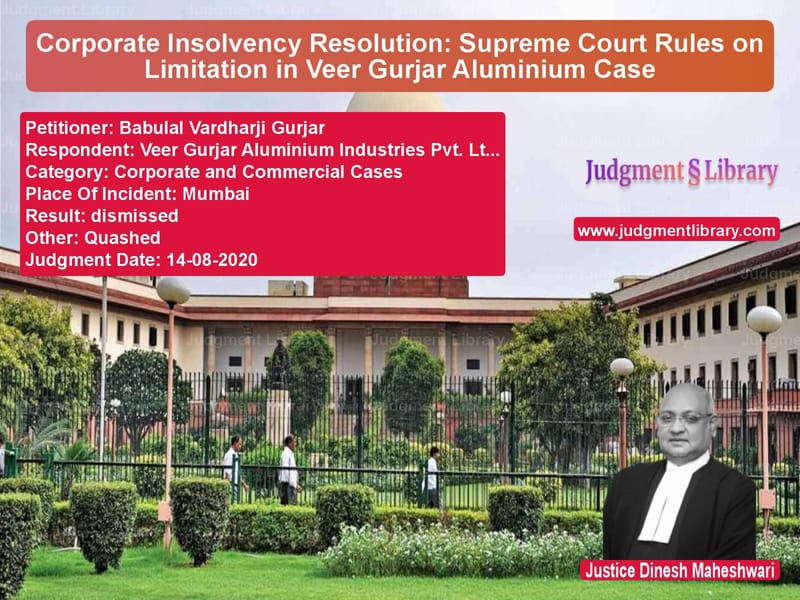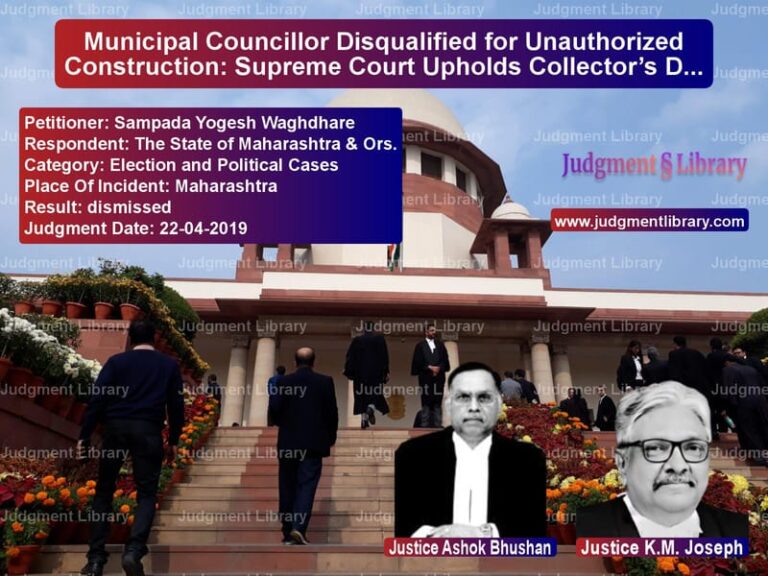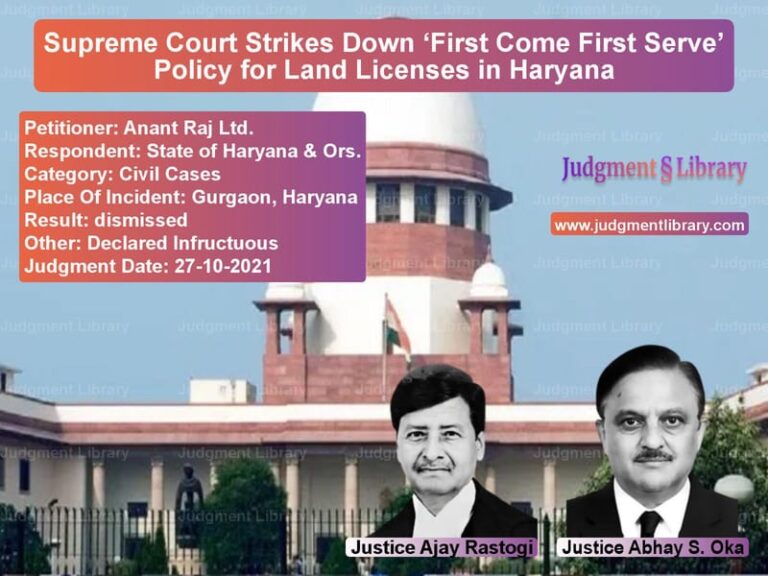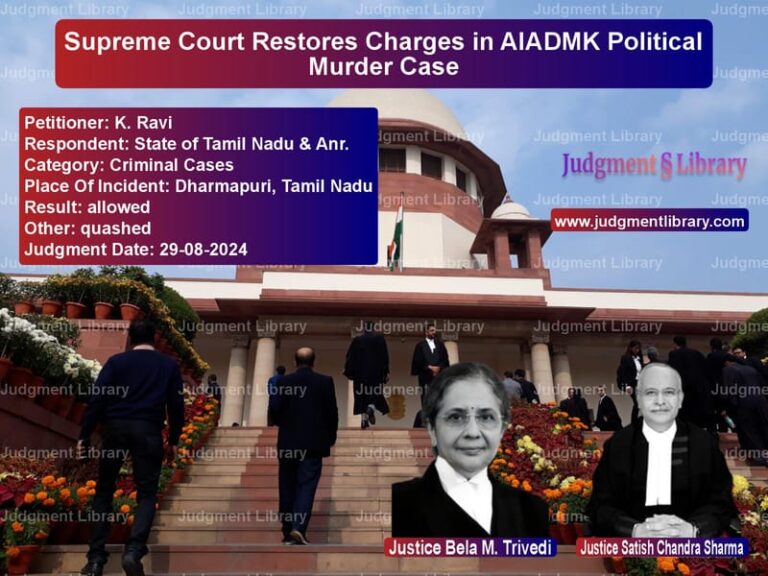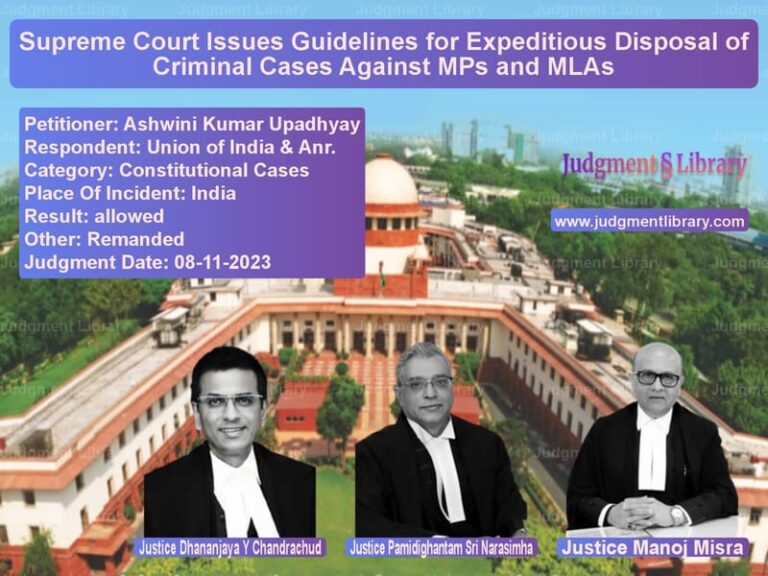Corporate Insolvency Resolution: Supreme Court Rules on Limitation in Veer Gurjar Aluminium Case
The case of Babulal Vardharji Gurjar vs. Veer Gurjar Aluminium Industries Pvt. Ltd. & Anr. revolved around the initiation of Corporate Insolvency Resolution Process (CIRP) under the Insolvency and Bankruptcy Code, 2016 (IBC). The primary legal issue before the Supreme Court was whether the application filed under Section 7 of the IBC was barred by limitation.
Background of the Case
The appellant, Babulal Vardharji Gurjar, had been a director of Veer Gurjar Aluminium Industries Pvt. Ltd. The respondent, JM Financial Assets Reconstruction Company Pvt. Ltd., filed an application under Section 7 of the IBC, claiming to be a financial creditor as the assignee of loans disbursed to the corporate debtor. The National Company Law Tribunal (NCLT), Mumbai, admitted the application and initiated CIRP.
The appellant challenged this decision before the National Company Law Appellate Tribunal (NCLAT), arguing that the application was barred by limitation. NCLAT dismissed the appeal, holding that the application was filed within the limitation period. The appellant then approached the Supreme Court.
Arguments by the Petitioner (Babulal Vardharji Gurjar)
- The petitioner contended that the limitation period for filing an application under Section 7 of the IBC is three years from the date of default, as per Article 137 of the Limitation Act, 1963.
- The date of default was explicitly mentioned in the application as 08.07.2011, and the application was filed in March 2018, well beyond the three-year limitation period.
- The petitioner argued that the NCLAT erred in holding that the limitation period started from 01.12.2016 (the date when the IBC came into force).
- The petitioner further argued that the acknowledgment of debt in financial statements or an offer for a one-time settlement (OTS) does not extend the limitation period.
Arguments by the Respondent (JM Financial Assets Reconstruction Company Pvt. Ltd.)
- The respondent contended that the liability was consistently acknowledged in the corporate debtor’s balance sheets, thereby extending the limitation period under Section 18 of the Limitation Act.
- The respondent argued that the initiation of CIRP was justified because the debt was continuously recognized and the corporate debtor had made an OTS proposal in 2018.
- It was also argued that since the IBC came into effect in 2016, the limitation period should be counted from that date.
Supreme Court’s Observations
The Supreme Court rejected the reasoning adopted by the NCLAT and made the following key observations:
- The limitation period for an application under Section 7 of the IBC is governed by Article 137 of the Limitation Act, which prescribes a three-year limitation from the date of default.
- The right to apply under Section 7 of the IBC accrues when the default occurs, not from the date when the IBC came into force.
- The date of default, as mentioned in the application, was 08.07.2011, making the application time-barred.
- The Supreme Court rejected the argument that acknowledgment of debt in balance sheets extends the limitation period for initiating CIRP.
- It was also clarified that a one-time settlement proposal does not constitute an acknowledgment of debt under Section 18 of the Limitation Act.
The Court held:
“The legislative policy now is to move away from the concept of ‘inability to pay debts’ to ‘determination of default.’ The limitation period under Article 137 begins from the date of default, and if an application is filed beyond this period, it is barred by time.”
Final Judgment and Implications
The Supreme Court set aside the orders passed by the NCLT and NCLAT and dismissed the application filed under Section 7 of the IBC, stating that it was barred by limitation. The ruling reaffirmed that CIRP cannot be initiated for time-barred debts.
This decision has significant implications for financial creditors, as it underscores the importance of adhering to the limitation period prescribed under the Limitation Act when filing insolvency applications.
Petitioner Name: Babulal Vardharji Gurjar.Respondent Name: Veer Gurjar Aluminium Industries Pvt. Ltd. & JM Financial Assets Reconstruction Company Pvt. Ltd..Judgment By: Justice Dinesh Maheshwari.Place Of Incident: Mumbai.Judgment Date: 14-08-2020.
Don’t miss out on the full details! Download the complete judgment in PDF format below and gain valuable insights instantly!
Download Judgment: Babulal Vardharji Gu vs Veer Gurjar Aluminiu Supreme Court of India Judgment Dated 14-08-2020.pdf
Direct Downlaod Judgment: Direct downlaod this Judgment
See all petitions in Bankruptcy and Insolvency
See all petitions in Corporate Compliance
See all petitions in Company Law
See all petitions in Judgment by Dinesh Maheshwari
See all petitions in dismissed
See all petitions in Quashed
See all petitions in supreme court of India judgments August 2020
See all petitions in 2020 judgments
See all posts in Corporate and Commercial Cases Category
See all allowed petitions in Corporate and Commercial Cases Category
See all Dismissed petitions in Corporate and Commercial Cases Category
See all partially allowed petitions in Corporate and Commercial Cases Category

